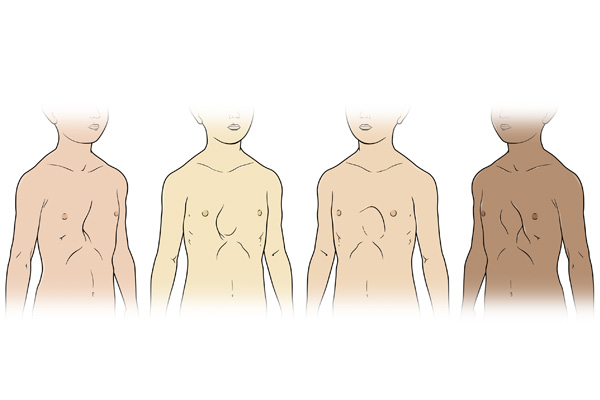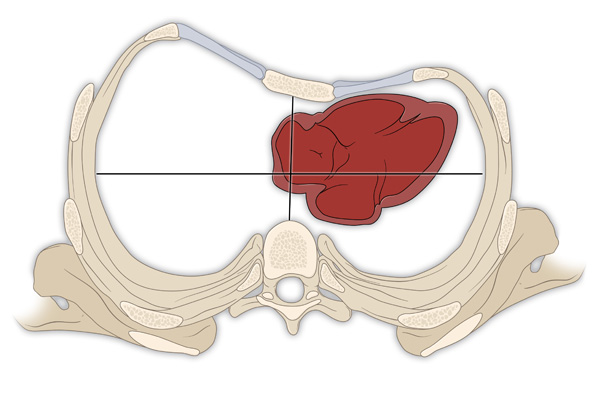Frequently Asked Questions About Pectus Excavatum and the Nuss Procedure
Get answers from CHOC experts to the most frequently asked questions about pectus excavatum and the Nuss procedure.
What causes pectus excavatum?
Although the cause is unknown, 40 percent of patients report a family history of pectus excavatum, and 40 percent of cases occur in tandem with scoliosis.
How common is pectus excavatum?
Pectus excavatum is one of the most common congenital chest wall abnormalities in children.
What does pectus excavatum look like?
Here are examples of how pectus excavatum (or sunken chest) looks, on the outside and the inside.


Is pectus excavatum dangerous?
Although some may think of pectus excavatum as purely a cosmetic problem, in severe cases, the limited chest cavity space can displace the heart as well as limit lung capacity. Fifteen percent of patients can experience arrhythmia (an abnormal heart rhythm) or mitral valve regurgitation, wherein the heart valves allow blood to leak backwards, as a result of the inward compression from the sternum.
How is pectus excavatum treated?
For severe cases of pectus excavatum, surgery to expand the chest wall can eliminate many symptoms. The pediatric surgeons at CHOC are experts at performing the minimally invasive Nuss procedure to repair pectus excavatum.
The Nuss procedure is a newer procedure that dramatically reduces the appearance of incisions and time spent in the operating room. A small incision is made on either side of the chest, and a small camera is inserted for observation as the surgeon passes a thin, curved metal bar through the chest cavity below the sternum. When the bar is flipped, the sunken chest is instantaneously repaired. The bar remains in place for two years, and is periodically monitored by a pediatric surgeon.
Your child will undergo a general anesthetic which will put him or her completely to sleep and prevents the sensation of pain. The full risks of anesthesia will be further explained by your child’s anesthesiologist.
Why choose the Nuss procedure?
A historical approach to these surgeries involved a large incision across the chest, and up to six hours in the operating room as the chest wall was taken apart and then reconstructed, known as the Ravitch procedure. There can also be significantly greater blood loss with the Ravitch procedure, and virtually none with the Nuss procedure.
The pectus excavatum team at CHOC is comprised of experts in pediatric pulmonology, cardiology and surgery. The multidisciplinary team performs various tests to examine heart and lung function, before and after surgery. By using the latest techniques in minimally invasive surgery, along with recent improvements in pain management, patients are able to return home and get back to their daily activities sooner than ever before.
What age is best to have a Nuss procedure?
The repair of pectus excavatum with a minimally invasive Nuss procedure has the best results when done between the ages of 12 and 15 years but are often performed on patients between 15-20.
How do I know if I am a candidate for a Nuss procedure?
If you have pectus excavatum (sunken chest), we will ask you to have three tests to determine if you are a candidate for a Nuss procedure. These include a cardiac MRI scan of the chest with a Haller index, a pulmonary consultation with lung function studies, and a cardiology consultation that includes a cardiac ECHO, EKG and CPX.
Is a Nuss procedure painful?
The operation does involve some pain but is minimized by our unique combination of multimodal pain management that is so effective that 65% of our patients go home the same day. We offer cryoablation which is a very new technique for pain control. Learn more about our pain management techniques for the Nuss procedure.
How long will my child’s recovery be?
We expect recovery to last for approximately two weeks, with minimal activity during that time.
When can my child get back to normal activities, especially sports?
The first four to six weeks after surgery are critical for healing. After six weeks, children may start doing cardiovascular exercises and lower body strengthening. After three months, most sports may resume.
How many Nuss procedures has CHOC done?
The pediatric surgeons at CHOC have done more than 300 successful Nuss procedures.
What are the biggest risks or complications that can occur from the Nuss procedure?
There are two possible complications that can occur. One is bar migration, and the other is infection.
How long has CHOC been doing this minimally invasive Nuss procedure?
Our CHOC pectus surgeons have been doing the Nuss procedure since 2001 with a very high patient satisfaction and success rate.












